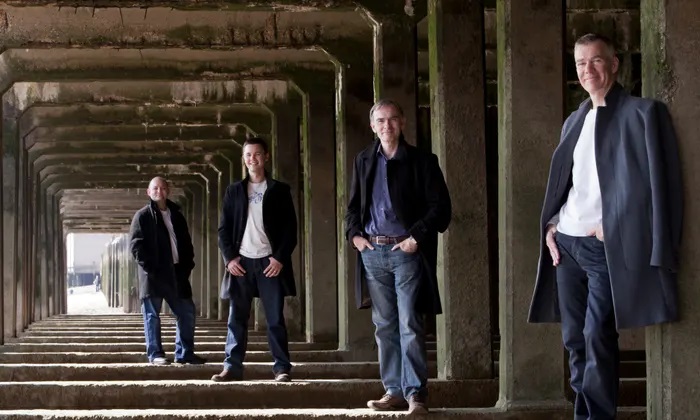
York Early Music Christmas Festival: Bojan Čičić, JS Bach’s Sonatas for solo violin, National Centre for Early Music, York, December 10
SEEING is believing. The magical sounds that Bojan Čičić coaxes from his baroque violin have not only to be heard, they need to be seen.
In 1720, while part of Prince Leopold’s court at Cöthen, Bach wrote six sonatas and partitas (effectively suites) for the unaccompanied violin, three of each, in response to the violin’s newly developed capability to play chords. This meant the possibility of adding a bass line to a melody.
They represent the Everest of the solo violin repertoire (not forgetting the Paganini caprices) and are fiendishly demanding. But they hold no terrors for this supremo. He is playing all six at this festival on consecutive Saturday lunchtimes and began here with the three sonatas. All fall into four movements.
The first is invariably slow, giving the player time to find their feet. The second, believe it or not, is a fugue, allowing the possibility of two or even three lines to overlap or seem to do so. The third is slower, often with origins in the dance, and the fourth is (very) fast.
Bach demonstrates throughout his intimate understanding of violin techniques at what was the cutting edge in his own day. The first two sonatas are in minor keys – G and A – and their opening movements have an elegiac quality. The third sonata, in C major, has a positively chordal opening, almost like a chorale.
All three are deceptive, because the succeeding fugues sound unplayable by a single instrument. In all, but especially the first, Čičić delivered incredible clarity, even playing down the countersubjects so that they did not overshadow the main subjects. There was also a touch of sheer bravura at the end of the second fugue.
The stately siciliana of No 1 demanded intense multiple-stopping – two or three notes at once – and the Andante of No 2, also a third movement, was so dense that you could have sworn that you were hearing several instruments.
All three finales took the breath away. The first was a high-speed moto perpetuo, allowing the player no respite. The Allegro of No 2 began innocently enough, but turned fierce, even including echo effects. The dazzling virtuosity of No 3’s finale brought the house down.
Čičić’s bow is a magic wand, but he does not brandish it at all pompously. On the contrary, his approach is almost self-effacing. The result is all the more sensational.
I cannot recommend his recital of Bach’s three partitas on Saturday (17/12/2022), at 1pm, highly enough. On this evidence, it is a totally mouth-watering prospect. Box office: 01904 658338 or ncem.co.uk
Review by Martin Dreyer

REVIEW: Spiritato with The Marian Consort, Inspiring Bach, National Centre for Early Music, York, December 11
THIS was almost two concerts in one, combining two groups – instrumental and vocal – who normally lead quite independent existences.
Spiritato, led from the violin by Kinga Ujszászi, is a chamber orchestra of some 18 players, dedicated to rekindling the unique sounds of the mid-17th century.
Joining them in this exploration is the 12-voice Marian Consort under its director and countertenor Rory McCleery.
Their programme, entitled Inspiring Bach, dealt with some of the bigger names that preceded the great man. The most notable of these was Johann Christoph Bach (1642-1703), who is widely regarded as the most important member of the Bach family before Johann Sebastian himself (and not to be confused with a later JCB, Johann Christian, the ‘English’ Bach). He was a composer and organist, who spent virtually all his career as harpsichordist at the Duke of Eisenach’s court.
The first of JC’s two contributions here was an elegiac cantata featuring McCleery’s countertenor (though he sang it on ground level more or less behind a pillar). More compelling was Es Erhub Sich Ein Streit, (‘There Arose A War’, a Picander text which JSB used for his Cantata 19) in which a bass duet was accompanied by two trumpets, before the brilliant tutti of the final chorus.
Given that there were no less than four trumpets on hand, all valveless and without finger holes, they were bound to capture the spotlight – and thrilling they were.
Possibly Sebastian Knüpfer’s last work, written just before he died in 1676, was Die Turteltaube Lässt Sich Hören(‘The Voice Of The Turtle Dove Is Heard’). It made clever use of soloists across the choir, building towards a final chorus in which the trumpets truly blazed.
On either side of this, we heard both Pachelbel’s and Bach’s settings of Christ Lag In Todesbanden (‘Christ Lay In Death’s Bonds’), based on a Lutheran Easter hymn – not especially seasonal, but good pieces anyway.
Pachelbel omits trumpets and timpani from his version, but contrasts vigorous, optimistic choruses with lighter episodes. Bach’s more familiar setting was distinguished here by an exciting acceleration into and through the Alleluia of the opening chorus and a brisk fugal finale.
A Buxtehude sonata, spotlighting violin and viola da gamba, allowed a brief excursion northwards into Denmark. It all amounted to a delightful concoction characterised as “music of healing in a time of catastrophe”.
Best of all, there was never a feeling, from either trumpets or strings, that the use of authentic instruments was in any way detracting from our enjoyment. On the contrary, these on-the-sleeve sounds enhanced our pleasure.
Review by Martin Dreyer

REVIEW: Orlando Consort, National Centre for Early Music, York, December 15
ORCHESTRAS may go on forever, but smaller groups tend to have a more limited life-span. The Orlando Consort has existed for no less than 35 years.
Astonishingly, two of its members have lasted the full course since 1988, tenor Angus Smith and baritone Donald Greig. Its other current members are countertenor Matthew Venner and tenor Mark Dobell, who took over from Robert Harre-Jones and
Charles Daniels respectively.
Between them, these six have established the Orlando as a world-class ensemble. Now the group has decided to call it a day and will give its last performance in June. So this final
appearance in York, where it has become a familiar visitor, was tinged with sadness.
A touch of nostalgia was in order and each of the singers in turn reminisced between groups about their experiences touring the world.
A seasonal start took us back to a Christmas trio from the Winchester Troper, whose earliest scribe began work around 1000 A.D. It included some fascinating stresses. A Machaut group from around 300 years later was more melismatic – multiple notes to a single syllable of text. A countertenor solo here was wonderfully expressive.
Before we embarked on a continental tour, two English composers gave a good account of
themselves. An anonymous Credo from Fountains Abbey dating to the early 15th century was positively bouncy, especially in its upper two voices. John Plummer’s Anna Mater Matris Christi was delightfully studded with imitation between the parts, highlighting the two tenors.
The three lower voices delivered a nicely tongue-in-cheek farewell to the wines of Lannoy, while the three upper ones made the complications of Vergine Bella, also by Dufay, sound ridiculously easy.
The quartet was more full-throated in Hortus Conclusus by the Spaniard Rodrigo de Ceballos, but without endangering its smooth ensemble. Italy yielded the incredibly busy Plaude Decus Mundi by Cristoforo de Monte (early 15th century), again dispatched with cool panache.
The Flemish masters were kept back for the finale. Josquin’s imitative techniques depend on singers alive to where the shifting spotlight should fall among them. The Orlando did not disappoint: in two motets, one with refrain, the tension ebbed and flowed beautifully.
Nicolas Gombert’s Quam Pulchra Es, sung last, was the most intricate and varied piece of the evening. It was stunningly fresh, with interest revolving between the voices, no mean feat after a full programme sung without vibrato.
These singers have flown the flag for Britain with distinction in all corners of the globe. They deserve our wholehearted thanks. Any just society would deck them with medals. In the King’s next birthday honours perhaps? Let’s hope so.
Review by Martin Dreyer
